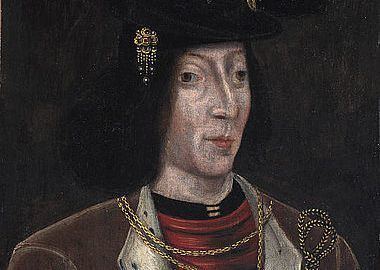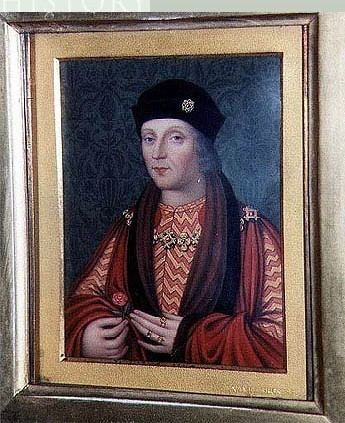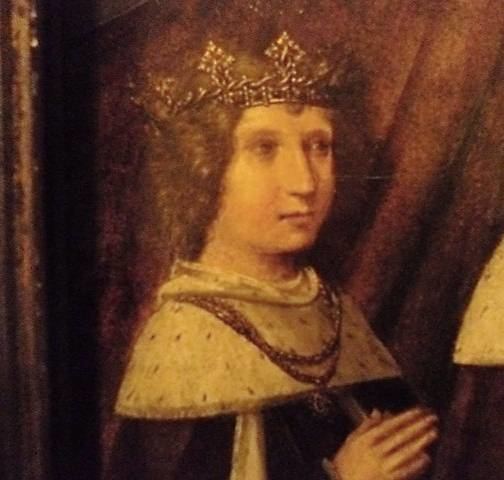Name Edmund 1st Buried St David's Cathedral | Children Henry VII of England | |
 | ||
Spouse Margaret Beaufort, Countess of Richmond and Derby (m. 1455) Parents Owen Tudor, Catherine of Valois Siblings Henry VI of England, Jasper Tudor, Duke of Bedford Similar People Owen Tudor, Henry VII of England, Henry VIII of England, Margaret Beaufort - Countess, Jasper Tudor - Duke of B | ||
Edmund Tudor, 1st Earl of Richmond (11 June 1430 – 3 November 1456), also known as Edmund of Hadham (Welsh: Edmwnd Tudur), was the father of King Henry VII of England and a member of the Tudor family of Penmynydd, North Wales. Born to Owen Tudor and the dowager queen Catherine of Valois, Edmund was half-brother to Henry VI of England. After being raised for several years by Katherine de la Pole, Henry took an interest in Edmund's upbringing. Once he came to age, Edmund was granted a title and lands by Henry. Both Edmund and his brother Jasper, were each made advisers to the King as they were his remaining blood relatives.
Contents
- Birth and early life
- Earl of Richmond
- Marriage and the Wars of the Roses
- Capture captivity and death
- References

They were made the senior Earls in the Royal Court and had influential positions in the Parliament of England. Edmund was also granted Baynard's Castle, London, and ran a successful estate. He was married to Margaret Beaufort, Countess of Richmond and Derby, after her first marriage was annulled. Prior to the start of the Wars of the Roses, Edmund liaised with Richard of York and supported him when the King fell ill during 1453 and 1454. After war began in 1455, York sent Edmund to uphold the authority of the King in South Wales. While he was there, York was overthrown by the King and in retaliation, Yorkist forces were sent to engage those of Tudor's in South Wales. Edmund was captured at Carmarthen Castle, and died there of the bubonic plague on 3 November 1456.

Birth and early life

Following the death of Henry V of England, the Queen dowager Catherine of Valois married Owen Tudor. The marriage was in secret, and was not common knowledge until after Catherine's death. It is accepted that Catherine and Owen were married around 1429/30, as the Queen stopped living in the household of her son, Henry VI and Owen was granted the rights of an Englishman in the Parliament of May 1432.
The children of Catherine and Owen were born away from court; their first son, Edmund, was born at Much Hadham Palace, Hertfordshire. The manor house was one owned by the Bishop of London. In 1436, his mother retired to Bermondsey Abbey, where she died on 3 January 1437. With Catherine dead, the Queen's enemies moved against Owen. He was called to London, and was acquitted by the Royal court of charges relating to the marriage. While en route to Wales, he was arrested and imprisoned in Newgate Prison. After he escaped in early 1438, he was recaptured and imprisoned once more in Windsor Castle.
Following the death of their mother and the imprisonment of their father, Edmund and his brother Jasper were brought up in the care of Katherine de la Pole, the daughter of Michael de la Pole, 2nd Earl of Suffolk, with whom they remained till at least March 1442. Henry VI began to take notice of his half-brothers by that point. He ensured that he was placed in the care of priests who oversaw their teaching. Edmund, along with his brother and father were taken into Henry's royal household. Henry was seemingly fond of his half brothers, and ennobled each of them with Edmund becoming Earl of Richmond on 15 December 1449 and Jasper, Earl of Pembroke on 23 November 1452.
Earl of Richmond
As Earls, and recognised by court as the King's half brothers, Edmund and Jasper had unparalleled precedence over the other laypersons in court with the exception of the Dukes. They were each given lands, although Jasper received a yearly stipend until Pembroke became available. After seven years of marriage to Margaret of Anjou, Henry was still without children. After the death of Humphrey, Duke of Gloucester, the royal line was at risk and considerations were made about the Tudor brothers inheriting the throne. There were concerns that while they had descended from the French royal line through Catherine, they had no blood relation to the English throne.
Both Edmund and Jasper were among a small group of personal advisers to the King by 1452, representing the only blood relations in court. However, neither was skilled at matters of state within England, and instead they were primarily given the task of ensuring the authority of the King within Wales. This resulted in a long held affection for the family in that country. The formal investiture of the duo took place in the Tower of London on 5 January 1453. Later that year on 6 March, they took their seats in the Parliament of England as the head of all the Earls in the court. After a petition by the House of Commons of England, both Jasper and Edmund were recognised officially as legitimate half-brothers of the King and removed the statutory disabilities attributed with being considered Welsh. Throughout 1452 and 1453, they were given large monetary grants from the King, while Edmund was also given property in Westmorland and Lancashire. Edmund ran a profitable estate and invested in the wool industry based out of Boston, Lincolnshire. The King also granted him the medieval palace of Baynard's Castle, near to the Thames river in London.
Marriage and the Wars of the Roses
Edmund was given the wardship of the nine-year-old Margaret Beaufort, Countess of Richmond and Derby, daughter of John Beaufort, 1st Duke of Somerset on 24 March 1453. She was the only heir of Beaufort and a kinswoman of the King. She had descended from the House of Lancaster through the eldest of John of Gaunt's bastard sons, John Beaufort. She had been previously married to John de la Pole, whose father, William de la Pole, 1st Duke of Suffolk had intended to seek the claim to the throne of her and any children should Henry fail to produce any heirs. William was murdered in 1450, and the marriage between Margaret and John was annulled in the first months of 1453 to enable her to be remarried to Edmund. It was this marriage on 1 November 1455 at Bletsoe Castle which enabled any offspring to lay claim to the English throne due to the inheritance of the Plantagenet blood through Margaret.
The marriage was consummated, leaving a 13-year-old widow who was seven months pregnant with their child at the time of his death.
A crisis emerged during the summer of 1453, as Henry fell ill lasting over 17 months, leaving him incommunicado and needing to be carried from place to place. Several parties sought to take power during this period, including Richard of York. Henry's wife, Margaret of Anjou, demanded to be declared Regent for the King, causing a division between her and the Tudor brothers who wished to lend assistance to York. However, Edmund did not attend the Parliament of 3 April 1454 where York was named protector of the realm during Henry's ongoing illness. Edmund continued to attend the advisory council for Richard of York, although not as frequently as his brother Jasper. Both brothers were in attendance during a meeting in November of that year when a decision was made to reduce the size of the Royal Household. As a result, they each received an entourage of a chaplain, two esquires, two yeomen and two chamberlains.
When the King recovered during the Christmas period of 1454, and dismissed York, with resultant hostility, it left both the Tudor brothers in a quandary. On 22 May 1455, Edmund was not present when the Wars of the Roses began with the First Battle of St Albans where Henry was captured by the forces of Richard of York. Both brothers attended the following Parliament where York was once again named Protector of England. While York cancelled the majority of the grants Henry had made during his reign, those to Edmund and Jasper were exempt. Both brothers were absent from the second session of Parliament that year when it began on 12 November; Edmund had been sent to Wales to ensure that the King's authority was enforced there after Gruffydd ap Nicholas had begun to move against other holdings.
Capture, captivity and death
Gryffydd made war with the troops under Edmund, capturing the castles at Aberystwyth, Carmarthen and Carreg Cennen by June 1456. The rebellion didn't last long, and by early August, Edmund's forces had retaken those castles although minor skirmishes continued for several months longer. While Edmund was in Wales, the King had deposed York. In retaliation, York sent 2,000 men under William Herbert on 10 August to take South Wales. When they arrived at Carmarthen Castle, they took the stronghold and captured Edmund Tudor.
As Herbert's troops moved on to Aberystwyth, Edmund was left behind, imprisoned in Carmarthen Castle. On 3 November 1456, Edmund became infected with the bubonic plague and died. He was buried at the nearby Franciscan Church in Carmarthen. There were suspicions that Edmund may have been murdered, and so a trial was held several months later with several parties accused, but no one was found guilty. Edmund's remains were removed to the choir of St David's Cathedral, Pembrokeshire in 1539, due to the dissolution of the monasteries enacted by King Henry VIII of England, of the Royal House of Tudor.
